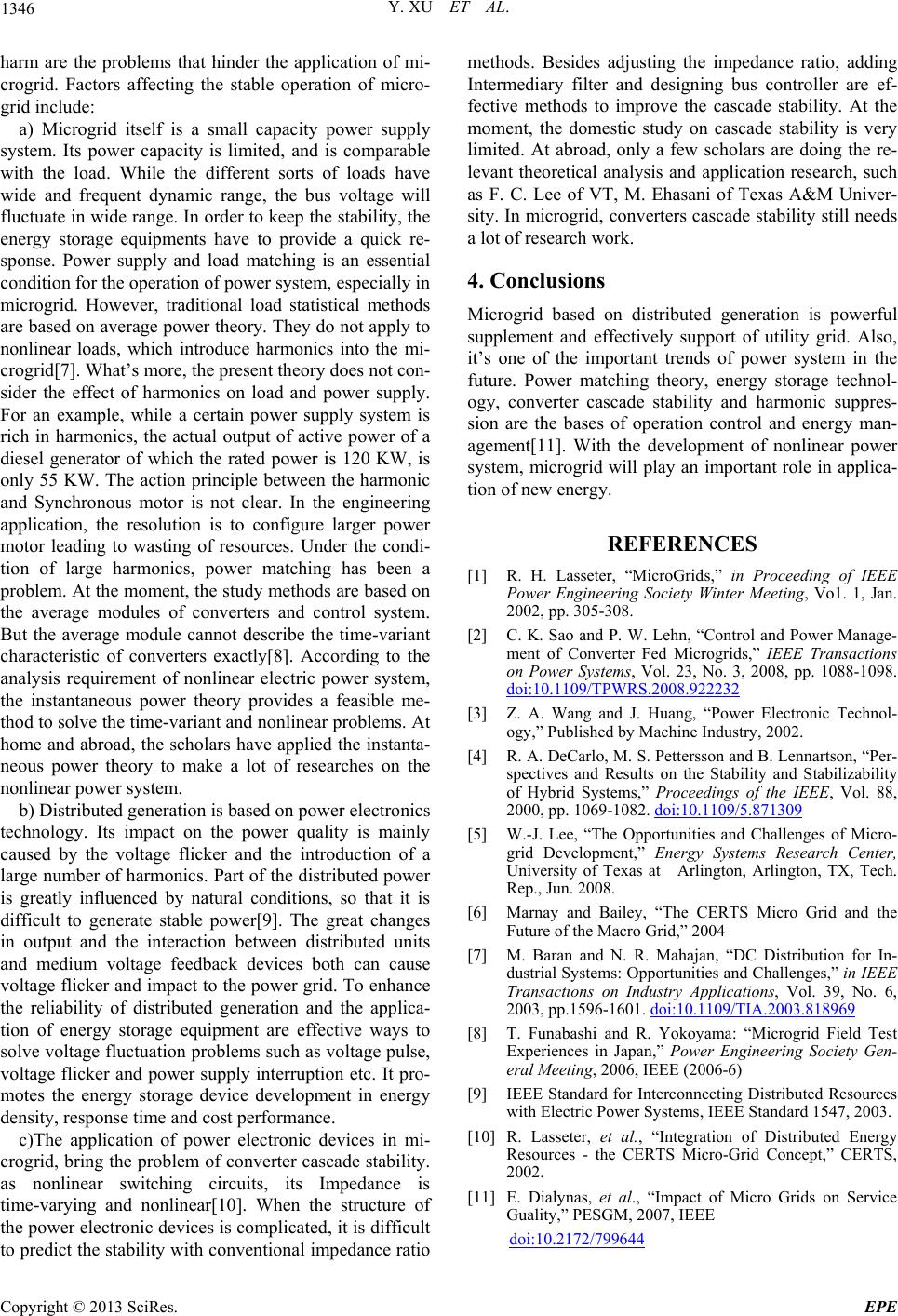
Y. XU ET AL.
Copyright © 2013 SciRes. EPE
1346
harm are the problems that hinder the application of mi-
crogrid. Factors affecting the stable operation of micro-
grid include:
a) Microgrid itself is a small capacity power supply
system. Its power capacity is limited, and is comparable
with the load. While the different sorts of loads have
wide and frequent dynamic range, the bus voltage will
fluctuate in wide range. In order to k eep the stability, the
energy storage equipments have to provide a quick re-
sponse. Power supply and load matching is an essential
condition for the operation of power system, especially in
microgrid. However, traditional load statistical methods
are based on average power theory. They do not apply to
nonlinear loads, which introduce harmonics into the mi-
crogrid[7]. What’s more, the present theory does not con-
sider the effect of harmonics on load and power supply.
For an example, while a certain power supply system is
rich in harmonics, the actual output of active power of a
diesel generator of which the rated power is 120 KW, is
only 55 KW. The action principle between the harmonic
and Synchronous motor is not clear. In the engineering
application, the resolution is to configure larger power
motor leading to wasting of resources. Under the condi-
tion of large harmonics, power matching has been a
problem. At the moment, the study methods are based on
the average modules of converters and control system.
But the average module cannot describe the time-variant
characteristic of converters exactly[8]. According to the
analysis requirement of nonlinear electric power system,
the instantaneous power theory provides a feasible me-
thod to solve the time-variant and nonlinear problems. At
home and abroad, the scholars have applied the instanta-
neous power theory to make a lot of researches on the
nonlinear pow er syst em.
b) Distributed generation is based on power electronics
technology. Its impact on the power quality is mainly
caused by the voltage flicker and the introduction of a
large number of harmonics. Part of the distributed power
is greatly influenced by natural conditions, so that it is
difficult to generate stable power[9]. The great changes
in output and the interaction between distributed units
and medium voltage feedback devices both can cause
voltage flicker and impact to the power grid. To enhan ce
the reliability of distributed generation and the applica-
tion of energy storage equipment are effective ways to
solve voltage fluctu ation problems such as voltage pulse,
voltage flicker and power supply interruption etc. It pro-
motes the energy storage device development in energy
density, response time and cost performance.
c)The application of power electronic devices in mi-
crogrid, bring the problem of converter cascade stability.
as nonlinear switching circuits, its Impedance is
time-varying and nonlinear[10]. When the structure of
the power electronic devices is complicated, it is difficult
o predict the stab ility with conventional impeda nce ratio
methods. Besides adjusting the impedance ratio, adding
Intermediary filter and designing bus controller are ef-
fective methods to improve the cascade stability. At the
moment, the domestic study on cascade stability is very
limited. At abroad, only a few scholars are doing the re-
levant theoretical analysis and application research, such
as F. C. Lee of VT, M. Ehasani of Texas A&M Univer-
sity. In microgrid, converters cascade stability still needs
a lot of research work.
t
4. Conclusions
Microgrid based on distributed generation is powerful
supplement and effectively support of utility grid. Also,
it’s one of the important trends of power system in the
future. Power matching theory, energy storage technol-
ogy, converter cascade stability and harmonic suppres-
sion are the bases of operation control and energy man-
agement[11]. With the development of nonlinear power
system, microgrid will play an important role in applica-
tion of new energy.
REFERENCES
[1] R. H. Lasseter, “MicroGrids,” in Proceeding of IEEE
Power Engineering Society Winter Meeting, Vo1. 1, Jan.
2002, pp. 305-308.
[2] C. K. Sao and P. W. Lehn, “Control and Power Manage-
ment of Converter Fed Microgrids,” IEEE Transactions
on Power Systems, Vol. 23, No. 3, 2008, pp. 1088-1098.
doi:10.1109/TPWRS.2008.922232
[3] Z. A. Wang and J. Huang, “Power Electronic Technol-
ogy,” Published by Machine Industry, 2002.
[4] R. A. DeCarlo, M. S. Pettersson and B. Lennartson, “Per-
spectives and Results on the Stability and Stabilizability
of Hybrid Systems,” Proceedings of the IEEE, Vol. 88,
2000, pp. 1069-1082. doi:10.1109/5.871309
[5] W.-J. Lee, “The Opportunities and Challenges of Micro-
grid Development,” Energy Systems Research Center,
University of Texas at Arlington, Arlington, TX, Tech.
Rep., Jun. 2008.
[6] Marnay and Bailey, “The CERTS Micro Grid and the
Future of the Macro Grid,” 2004
[7] M. Baran and N. R. Mahajan, “DC Distribution for In-
dustrial Systems: Opportunities and Challenges,” in IEEE
Transactions on Industry Applications, Vol. 39, No. 6,
2003, pp.1596-1601. doi:10.1109/TIA.2003.818969
[8] T. Funabashi and R. Yokoyama: “Microgrid Field Test
Experiences in Japan,” Power Engineering Society Gen-
eral Meeting, 2006, IEEE (2006-6)
[9] IEEE Standard for Interconnecting Distributed Resources
with Electric Power Systems, IEEE Standard 1547, 2003.
[10] R. Lasseter, et al., “Integration of Distributed Energy
Resources - the CERTS Micro-Grid Concept,” CERTS,
2002.
[11] E. Dialynas, et al., “Impact of Micro Grids on Service
Guality,” PESGM, 2007, IEEE
doi:10.2172/799644